-
黑马C++ 03 提高5 —— STL常用容器_stack栈容器/queue队列容器/list链表容器
一、stack栈容器(先进后出)
1. stack基本概念(顶端元素才被使用)
- 概念:stack是一种先进后出(First In Last Out,FILO)的数据结构,它只有一个出口。
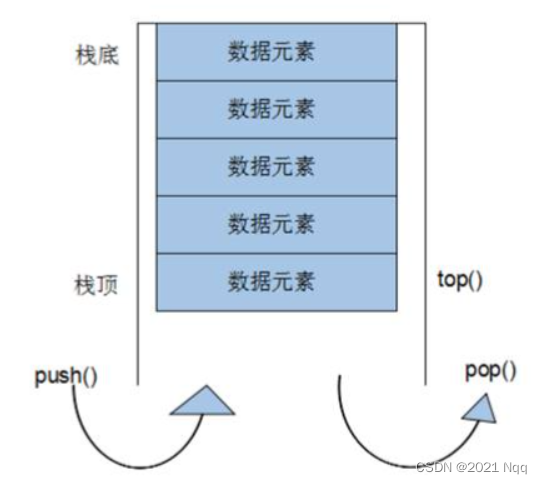
- 栈中只有顶端的元素才可以被外界使用,因此栈不允许有遍历行为
- 栈中进入数据称为 — 入栈
push - 栈中弹出数据称为 — 出栈
pop
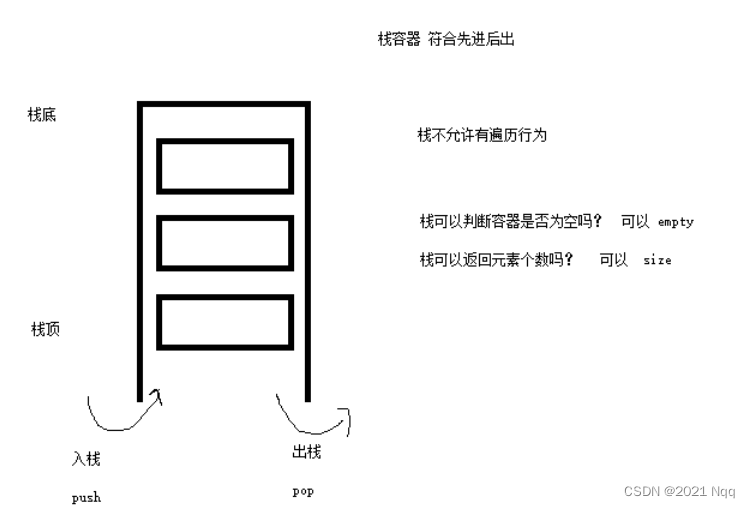
2. stack常用接口
功能描述: 栈容器常用的对外接口
构造函数:stackstack采用模板类实现, stack对象的默认构造形式stk; stack(const stack &stk);拷贝构造函数
赋值操作:
stack& operator=(const stack &stk);重载等号操作符
数据存取:
push(elem);向栈顶添加元素pop();从栈顶移除第一个元素top();返回栈顶元素
大小操作:
empty();判断堆栈是否为空size();返回栈的大小
总结:
- 入栈 — push
- 出栈 — pop
- 返回栈顶 — top
- 判断栈是否为空 — empty
- 返回栈大小 — size
#include#include #include using namespace std; // stack容器符合先进后出,不允许有遍历行为 // 栈stack容器 void test01() { // 特点:符合先进后出的数据结构 stack<int>s; // 入栈 s.push(10); s.push(20); s.push(30); s.push(40); cout << "栈的大小:" << s.size() << endl; // 主要栈不为空,查看栈顶,并且执行出栈操作 while (!s.empty())// 不为空 { // 查看栈顶的元素 cout << "栈顶元素为:" << s.top() << endl; // 出栈 s.pop(); } cout << "栈的大小:" << s.size() << endl; } int main() { test01(); system("pause"); return 0; } - 1
- 2
- 3
- 4
- 5
- 6
- 7
- 8
- 9
- 10
- 11
- 12
- 13
- 14
- 15
- 16
- 17
- 18
- 19
- 20
- 21
- 22
- 23
- 24
- 25
- 26
- 27
- 28
- 29
- 30
- 31
- 32
- 33
- 34
- 35
- 36
- 37
- 38
- 39
- 40
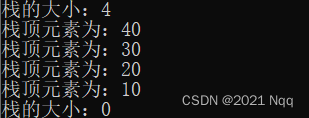
二、queue队列容器(先进先出)
1. queue基本概念(队头队尾元素才被使用)
- 概念:Queue是一种先进先出(First In First Out,FIFO)的数据结构,它有两个出口。
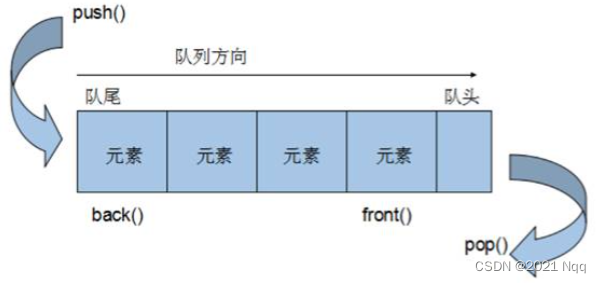
- 队列容器允许从一端新增元素,从另一端移除元素。
- 队列中只有队头和队尾才可以被外界使用,因此队列不允许有遍历行为。
- 队列中进数据称为 — 入队
push - 队列中出数据称为 — 出队
pop
2. queue常用接口
功能描述: 栈容器常用的对外接口
构造函数:queuequeue采用模板类实现,queue对象的默认构造形式que; queue(const queue &que);拷贝构造函数
赋值操作:
queue& operator=(const queue &que);重载等号操作符
数据存取:
push(elem);往队尾添加元素pop();从队头移除第一个元素back();返回最后一个元素front();返回第一个元素
大小操作:
empty();判断堆栈是否为空size();返回栈的大小
总结:
- 入队 — push
- 出队 — pop
- 返回队头元素 — front
- 返回队尾元素 — back
- 判断队是否为空 — empty
- 返回队列大小 — size
#include#include #include #include #include using namespace std; // queue先进先出,只有队头和队尾能给外界访问,因此不允许有遍历行为 // 队列queue class Person { public: Person(string name, int age) { this->m_Name = name; this->m_Age = age; } string m_Name; int m_Age; }; void test01() { // 创建队列 queue<Person>q; // 准备数据 Person p1("唐僧", 30); Person p2("孙悟空", 1000); Person p3("猪八戒", 900); Person p4("沙僧", 800); // 入队 q.push(p1); q.push(p2); q.push(p3); q.push(p4); cout << "队列的大小:" << q.size() << endl; // 判断只要队列不为空,查看队头,查看队尾,出队 while (!q.empty()) { // 查看队头 cout << "队头元素——姓名: " << q.front().m_Name << "年龄: " << q.front().m_Age << endl; // 查看队尾 cout << "队尾元素——姓名: " << q.back().m_Name << "年龄: " << q.back().m_Age << endl; // 出队,先进先出 q.pop(); } cout << "队列的大小:" << q.size() << endl; } int main() { test01(); system("pause"); return 0; } - 1
- 2
- 3
- 4
- 5
- 6
- 7
- 8
- 9
- 10
- 11
- 12
- 13
- 14
- 15
- 16
- 17
- 18
- 19
- 20
- 21
- 22
- 23
- 24
- 25
- 26
- 27
- 28
- 29
- 30
- 31
- 32
- 33
- 34
- 35
- 36
- 37
- 38
- 39
- 40
- 41
- 42
- 43
- 44
- 45
- 46
- 47
- 48
- 49
- 50
- 51
- 52
- 53
- 54
- 55
- 56
- 57
- 58
- 59
- 60
- 61
- 62
- 63
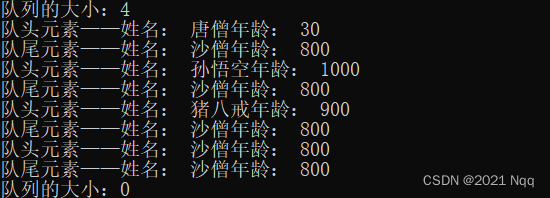
三、list链表容器
1. list基本概念
- 功能: 将数据进行链式存储
- 链表(list)是一种物理存储单元上非连续的存储结构,数据元素的逻辑顺序是通过链表中的指针链接实现的。
- 链表的组成:链表由一系列结点组成。
- 结点的组成:一个是存储数据元素的数据域,另一个是存储下一个结点地址的指针域。
- STL中的链表是一个双向循环链表,既指向前一个节点,又指向后一个节点。

- 由于链表的存储方式并不是连续的内存空间,因此链表list中的迭代器只支持前移和后移,属于双向迭代器
list的优点:
- 采用动态存储分配,不会造成内存浪费和溢出
- 链表执行插入和删除操作十分方便,修改指针即可,不需要移动大量元素
list的缺点:
- 链表灵活,但是空间(指针域) 和 时间(遍历)额外耗费较大
重要性质:
- List有一个重要的性质,插入操作和删除操作都不会造成原有list迭代器的失效,这在vector是不成立的。
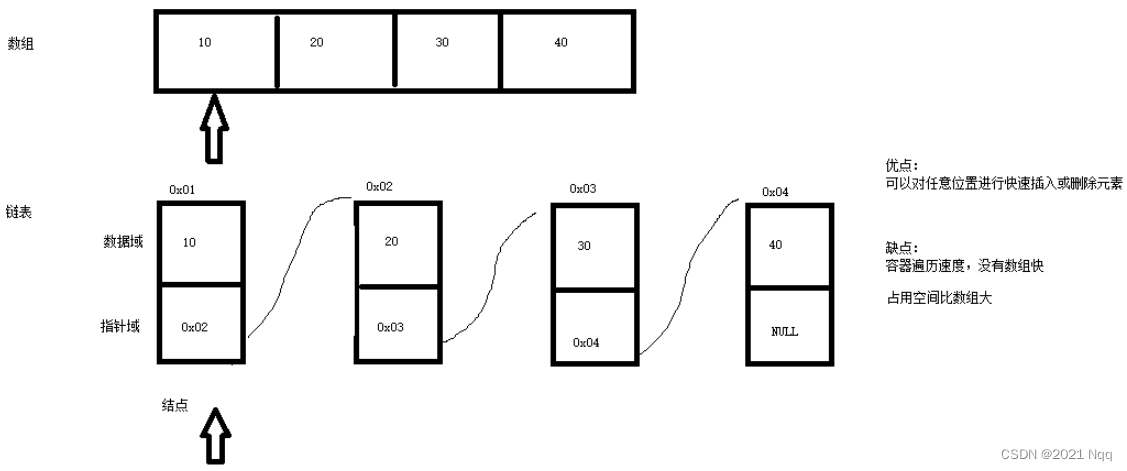
- 遍历速度没有指针快,因为数组地址是连续的
- 总结:STL中List和vector是两个最常被使用的容器,各有优缺点。
2. list构造函数
功能描述:
- 创建list容器
函数原型:
listlist采用采用模板类实现,对象的默认构造形式:lst; list(beg,end);构造函数将[beg, end)区间中的元素拷贝给本身。list(n,elem);构造函数将n个elem拷贝给本身。list(const list &lst);拷贝构造函数
总结:
- list构造方式同其他几个STL常用容器,熟练掌握即可
#include#include #include #include - 1
- 2
- 3
- 4
- 5
- 6
- 7
- 8
- 9
- 10
- 11
- 12
- 13
- 14
- 15
- 16
- 17
- 18
- 19
- 20
- 21
- 22
- 23
- 24
- 25
- 26
- 27
- 28
- 29
- 30
- 31
- 32
- 33
- 34
- 35
- 36
- 37
- 38
- 39
- 40
- 41
- 42
- 43
- 44
- 45
- 46
- 47
- 48
- 49
- 50

3. list赋值与交换(加const)
功能描述:
- 给list容器进行赋值,以及交换list容器
函数原型:
assign(beg, end);将[beg, end)区间中的数据拷贝赋值给本身。assign(n, elem);将n个elem拷贝赋值给本身。list& operator=(const list &lst);重载等号操作符swap(lst);将lst与本身的元素互换。
总结:
- list赋值和交换操作能够灵活运用即可
#include#include #include - 1
- 2
- 3
- 4
- 5
- 6
- 7
- 8
- 9
- 10
- 11
- 12
- 13
- 14
- 15
- 16
- 17
- 18
- 19
- 20
- 21
- 22
- 23
- 24
- 25
- 26
- 27
- 28
- 29
- 30
- 31
- 32
- 33
- 34
- 35
- 36
- 37
- 38
- 39
- 40
- 41
- 42
- 43
- 44
- 45
- 46
- 47
- 48
- 49
- 50
- 51
- 52
- 53
- 54
- 55
- 56
- 57
- 58
- 59
- 60
- 61
- 62
- 63
- 64
- 65
- 66
- 67
- 68
- 69
- 70
- 71
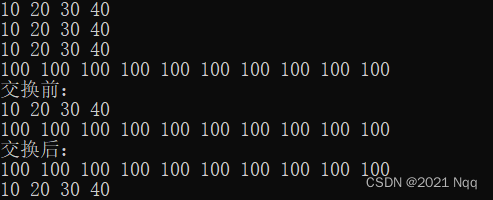
4. list大小操作
功能描述:
- 对list容器的大小进行操作
函数原型:
size();返回容器中元素的个数empty();判断容器是否为空resize(num);重新指定容器的长度为num,若容器变长,则以默认值填充新位置;如果容器变短,则末尾超出容器长度的元素被删除。resize(num, elem);重新指定容器的长度为num,若容器变长,则以elem值填充新位置;如果容器变短,则末尾超出容器长度的元素被删除。
总结:
- 判断是否为空 — empty
- 返回元素个数 — size
- 重新指定个数 — resize
#include#include - 1
- 2
- 3
- 4
- 5
- 6
- 7
- 8
- 9
- 10
- 11
- 12
- 13
- 14
- 15
- 16
- 17
- 18
- 19
- 20
- 21
- 22
- 23
- 24
- 25
- 26
- 27
- 28
- 29
- 30
- 31
- 32
- 33
- 34
- 35
- 36
- 37
- 38
- 39
- 40
- 41
- 42
- 43
- 44
- 45
- 46
- 47
- 48
- 49
- 50

5. list插入与删除
功能描述:
- 对list容器进行数据的插入和删除
函数原型:
push_back(elem);在容器尾部加入一个元素pop_back();删除容器中最后一个元素push_front(elem);在容器开头插入一个元素pop_front();从容器开头移除第一个元素insert(pos,elem);在pos位置插elem元素的拷贝,返回新数据的位置。insert(pos,n,elem);在pos位置插入n个elem数据,无返回值。insert(pos,beg,end);在pos位置插入[beg,end)区间的数据,无返回值。clear();移除容器的所有数据erase(beg,end);删除[beg,end)区间的数据,返回下一个数据的位置。erase(pos);删除pos位置的数据,返回下一个数据的位置。remove(elem);删除容器中所有与elem值匹配的元素
总结:
- 尾插 — push_back
- 尾删 — pop_back
- 头插 — push_front
- 头删 — pop_front
- 插入 — insert
- 删除 — erase
- 移除 — remove
- 清空 — clear
#include#include - 1
- 2
- 3
- 4
- 5
- 6
- 7
- 8
- 9
- 10
- 11
- 12
- 13
- 14
- 15
- 16
- 17
- 18
- 19
- 20
- 21
- 22
- 23
- 24
- 25
- 26
- 27
- 28
- 29
- 30
- 31
- 32
- 33
- 34
- 35
- 36
- 37
- 38
- 39
- 40
- 41
- 42
- 43
- 44
- 45
- 46
- 47
- 48
- 49
- 50
- 51
- 52
- 53
- 54
- 55
- 56
- 57
- 58
- 59
- 60
- 61
- 62
- 63
- 64
- 65
- 66
- 67
- 68
- 69
- 70
- 71
- 72
- 73
- 74
- 75
- 76
- 77
- 78
- 79
- 80
- 81
- 82
- 83
- 84
- 85
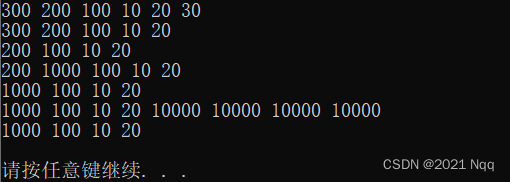
6. list数据存取
功能描述:
- 对list容器中数据进行存取
函数原型:
front();返回第一个元素。back();返回最后一个元素。
总结:
- list容器中不可以通过[]或者at方式访问数据,因为存储空间不是连续的,且迭代器不支持随机访问
- list本质是个链表,每个数据不是用连续的线性空间存储数据,数据地址不是连续的,迭代器也是不支持随机访问,
- 返回第一个元素 — front
- 返回最后一个元素 — back
#include#include - 1
- 2
- 3
- 4
- 5
- 6
- 7
- 8
- 9
- 10
- 11
- 12
- 13
- 14
- 15
- 16
- 17
- 18
- 19
- 20
- 21
- 22
- 23
- 24
- 25
- 26
- 27
- 28
- 29
- 30
- 31
- 32
- 33
- 34

7. list反转和排序
功能描述:
- 将容器中的元素反转,以及将容器中的数据进行排序
函数原型:
reverse();反转链表sort();链表排序
总结:
- 反转 — reverse
- 排序 — sort (成员函数)
- 所有不支持随机访问迭代器的容器,不可以用标准的算法
- 不支持随机访问迭代器的容器,内部会提供对应的一些算法
#include#include - 1
- 2
- 3
- 4
- 5
- 6
- 7
- 8
- 9
- 10
- 11
- 12
- 13
- 14
- 15
- 16
- 17
- 18
- 19
- 20
- 21
- 22
- 23
- 24
- 25
- 26
- 27
- 28
- 29
- 30
- 31
- 32
- 33
- 34
- 35
- 36
- 37
- 38
- 39
- 40
- 41
- 42
- 43
- 44
- 45
- 46
- 47
- 48
- 49
- 50
- 51
- 52
- 53
- 54
- 55
- 56
- 57
- 58
- 59
- 60
- 61
- 62
- 63
- 64
- 65
- 66
- 67
- 68
- 69
- 70
- 71
- 72
- 73
- 74
- 75
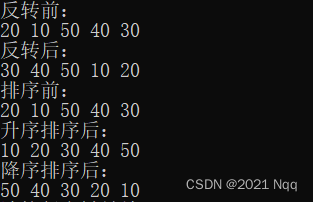
8. list排序案例
- 案例描述:将Person自定义数据类型进行排序,Person中属性有姓名、年龄、身高
- 排序规则:按照年龄进行升序,如果年龄相同按照身高进行降序
#include#include using namespace std; class Person { public: Person(string name, int age, int height) { this->m_Name = name; this->m_Age = age; this->m_Height = height; } string m_Name;// 姓名 int m_Age;// 年龄 int m_Height;// 身高 }; // 指定排序规则,返回的是bool类型的数据 bool comparePerson(Person &p1,Person &p2) { // 要求:首先按照年龄做升序,然后年龄相同下做身高的降序排序 if (p1.m_Age == p2.m_Age) { // 年龄相同下做身高的降序排序 return p1.m_Height > p2.m_Height; } else { return p1.m_Age < p2.m_Age; } } void test01() { list<Person>L;// 创建容器 // 准备数据 Person p1("刘备", 35, 175); Person p2("曹操", 45, 180); Person p3("孙权", 40, 170); Person p4("赵云", 25, 190); Person p5("张飞", 35, 160); Person p6("关羽", 35, 200); // 插入数据 L.push_back(p1); L.push_back(p2); L.push_back(p3); L.push_back(p4); L.push_back(p5); L.push_back(p6); cout << "排序前:" << endl; for (list<Person>::iterator it = L.begin(); it != L.end(); it++) { cout << "姓名: " << (*it).m_Name << " 年龄: " << it->m_Age << " 身高: " << it->m_Height << endl; } // 排序后 cout << "----------------------------------" << endl; cout << "排序后:" << endl; L.sort(comparePerson);// 必须写一个回调函数或者仿函数,指定排序规则 for (list<Person>::iterator it = L.begin(); it != L.end(); it++) { cout << "姓名: " << (*it).m_Name << " 年龄: " << it->m_Age << " 身高: " << it->m_Height << endl; } } int main() { test01(); system("pause"); return 0; } - 1
- 2
- 3
- 4
- 5
- 6
- 7
- 8
- 9
- 10
- 11
- 12
- 13
- 14
- 15
- 16
- 17
- 18
- 19
- 20
- 21
- 22
- 23
- 24
- 25
- 26
- 27
- 28
- 29
- 30
- 31
- 32
- 33
- 34
- 35
- 36
- 37
- 38
- 39
- 40
- 41
- 42
- 43
- 44
- 45
- 46
- 47
- 48
- 49
- 50
- 51
- 52
- 53
- 54
- 55
- 56
- 57
- 58
- 59
- 60
- 61
- 62
- 63
- 64
- 65
- 66
- 67
- 68
- 69
- 70
- 71
- 72
- 73
- 74
- 75
- 76
- 77
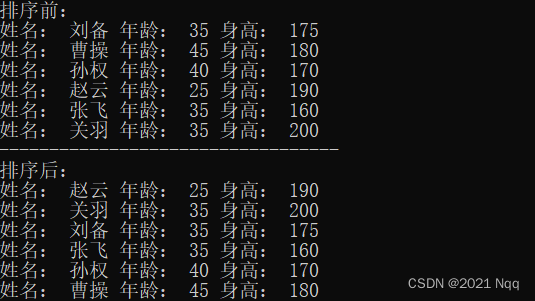
-
相关阅读:
Android之根据时区获取当前时间
Vue项目的记录(七)
【图像处理GIU】图像分割(Matlab代码实现)
我所遇到的web前端最常见的面试 - 后续不断更新
Ubuntu 22.04 LTS 入门安装配置&优化、开发软件安装一条龙
小满nestjs(第十章 nestjs 提供者)
【AI】深度学习——人工智能、深度学习与神经网络
基于Java公益志愿捐赠管理系统设计与实现(源码+LW+调试+开题报告)
高等数学(第七版)同济大学 习题8-1 个人解答
H5链接分享到微信中形成小卡片(后端代码签名实现(超详细))
- 原文地址:https://blog.csdn.net/qq_42731062/article/details/127639504
